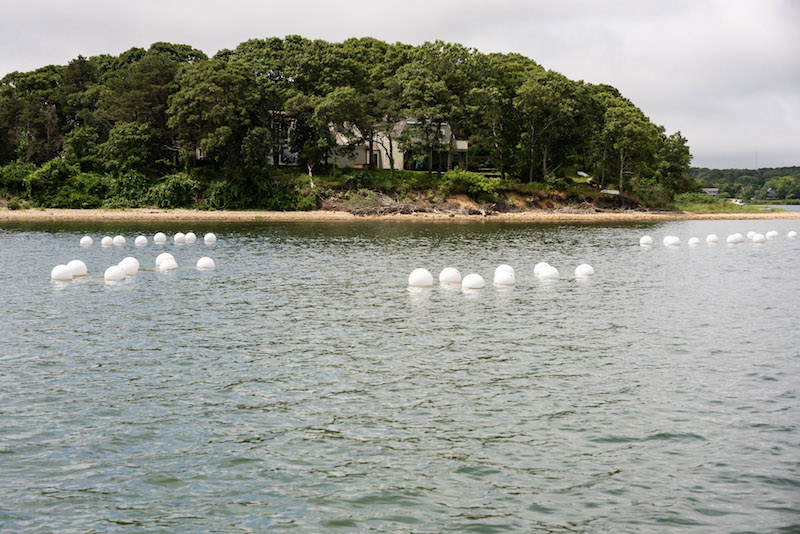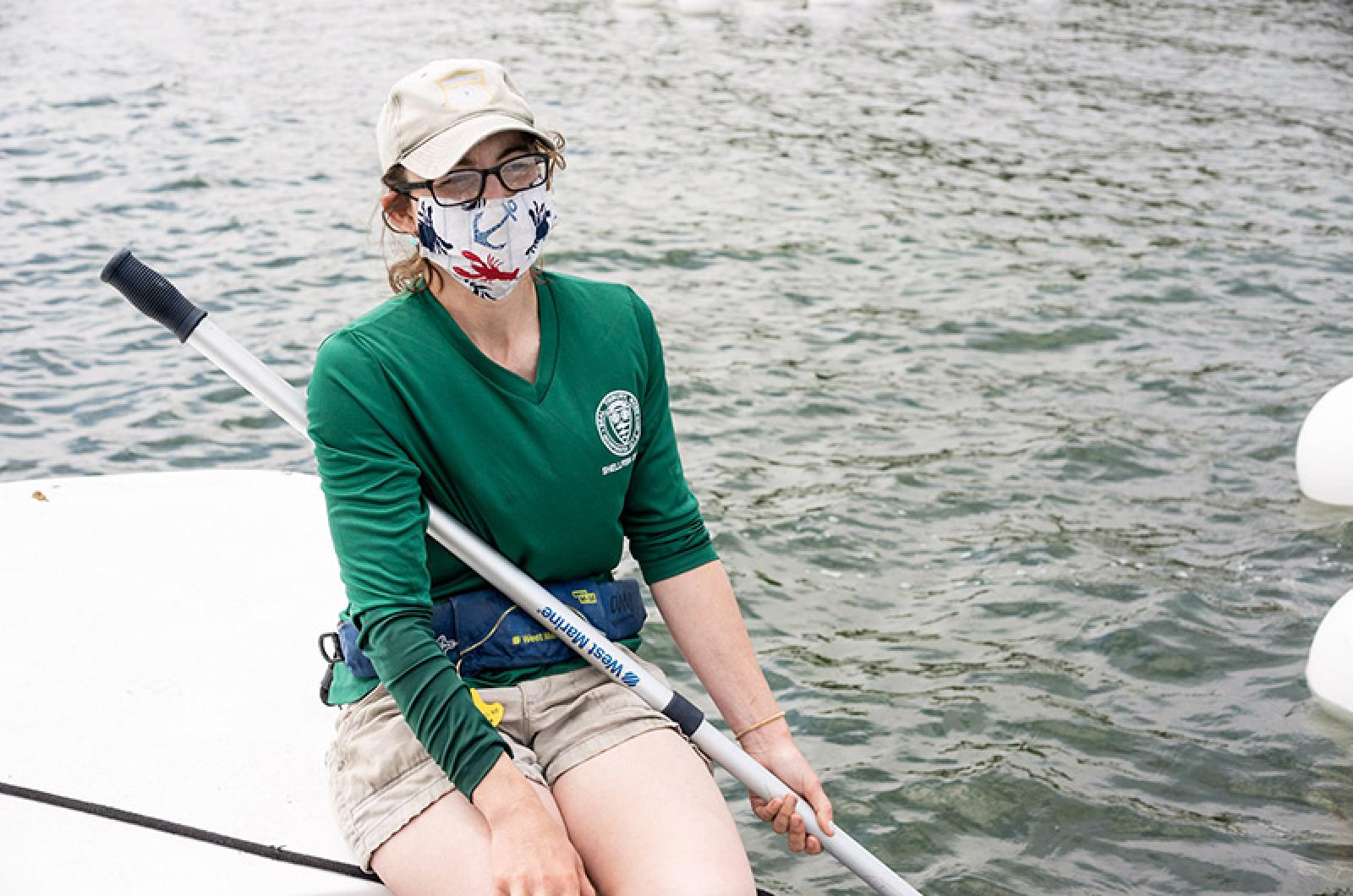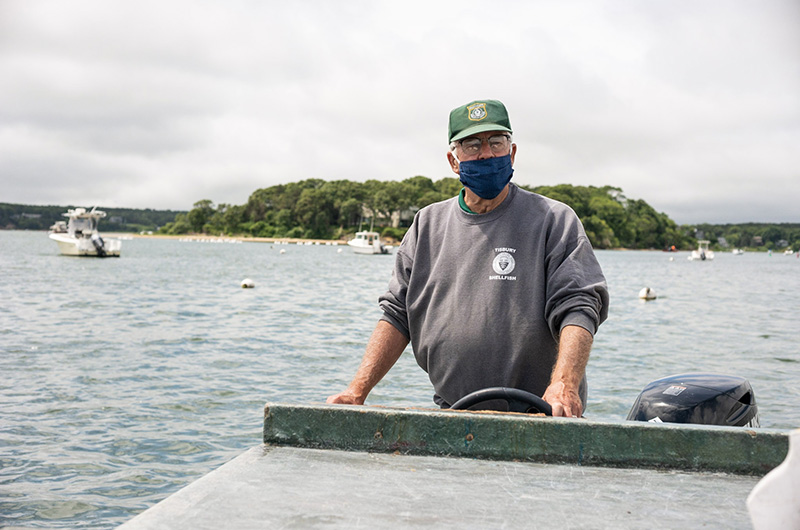Tisbury shellfish constable Danielle Ewart had her boat loaded with 225,000 quahaugs. Fully grown, the hard-shelled clams would have weighed upwards of 40 tons. But on this particular day, the quahaugs fitted nicely into three plastic bags.
For Ms. Ewart and her assistant Fred Benson, it marked both the beginning and end of a journey. A winter-long process to produce the seed at the Martha’s Vineyard Shellfish Group’s Lagoon Pond hatchery was coming to an end. But it also was the start of a process to grow the grain-sized seed into shellfish that can be harvested, eaten or even returned to the hatchery to produce more seed years down the line.
“It’s the beginning, I think,” Ms. Ewart decided, leaning over the boat and sprinkling seed quahaugs, a few thousand at a time, into custom-built floating crates submerged in the pond. “This is the first time they are seeing sand, and the first time they can eat really good food and settle in safely.”
The seed quahaugs are poppy seed-sized versions of what they look like when full grown. The shells are purple striped, and the quahaugs have a tiny foot for movement. Once they have grown to about the size of a thumbnail, sometime in late summer, they will be moved to the west arm of the pond to continue to grow and fend for themselves in a more natural habitat. The west arm area has been closed to shellfishing since February, and recently reopened after passing a state water quality test, Ms. Ewart said.
But for the next few months, the quahaugs will float on a sandy bed above the pond bottom, safely out of reach of predators like crabs, and under the watchful eye of Ms. Ewart and her team.
Quahaugs have a rich and storied history in New England’s coastal ponds. The name is believed to have its origins in the Narragansett word poquahock, which is similar to the Wampanoag word, meaning hard clam. Shell middens on the Island date back thousands of years to the present day, and today are often found in piles alongside boat landings.

In the context of such a long history, shellfish management is a fairly new concept, Ms. Ewart said, and came about in response to overfishing and pollution from nitrogen that degrades the water quality in the ponds. Plus there is a cultural desire to maintain a harvest and and restore the environment. Quahaugs are one of the strongest native species capable of filtering pollutants — which in turn enhances water quality and helps other species thrive, she said.
Ms. Ewart dates shellfish management in its modern form to the latter half of the 20th century. Since then, she said it has been an evolving process of trial and error to control predators, maximize productivity and keep the pond environment in balance.
And that includes seeding.
“If there wasn’t any stock enhancement there would be no shellfish on the Island,” Ms. Ewart said. “We are always coming up with new techniques to develop our seeding operation in different ways. On the Island, each town has their own different technique.”
Ms. Ewart said in her 10 years as constable, she has tested new techniques each year. She has meddled with car batteries, boat pumps and growing in different areas in the lagoon.
This year she replaced the blue polystyrene blocks used to keep the crates afloat with plastic moorings. She said the polystyrene would break down in the water, potentially harming the environment, and she had been hoping to eliminate it for years. The mooring technique also gives the quahaugs more sunlight. She also reduced the amount of seed by about 25 per cent this year. Though last year yielded a strong quahaug harvest, she said her aim is to give the shellfish more room to grow.
“If a new technique works well, we stick to it. At least until we think of something else,” she said. “It’s kind of like trying to patch a boat in the water, it’s not that easy to do.”
Back at the town landing, Ms. Ewart looked out over the lagoon. The quahaug seed in, she was already turning her attention to the bay scallops, just entering their spawning phase, and an eel grass restoration project. Each thing is separate, she said, but connected to the overall health of the water.
“It’s more than just growing shellfish to be harvested. We are trying holistically help the pond,” she said. “This is just one part.”








Comments (4)
Comments
Comment policy »